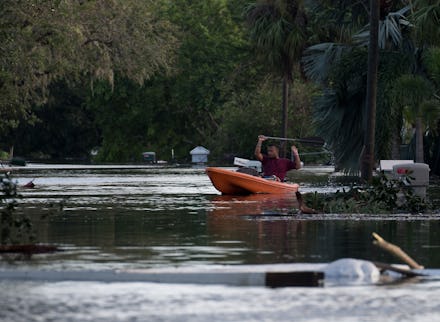Hurricane Irma’s devastation could be much more severe than we think, scientists say

Hurricane Irma’s path of destruction isn’t over. After whirling through the Caribbean and Florida, leaving dozens dead and millions without power, it has now been reduced to a tropical storm. But more damage may still be coming: Irma is reportedly heading for Georgia and other southern states with 70 mph winds reported Monday morning.
Barbuda, a small Caribbean island, bore the biggest burden when Irma first touched down; it was essentially leveled by the then-Category 5 storm. About 90% of the island’s land structures have been lost, according to the nation’s prime minister, and 60% of the island’s residents are now homeless.
“It’s hard to imagine what nature can really do,” said Kristen Allen, a 26-year-old whose family lives in Barbuda’s neighboring island of Antigua. “It can be extremely scary.” Although Antigua suffered less destruction, Allen was still waiting to hear from several family members as of Friday. “It’s going to take years to rebuild and to get things to the way it was before Irma,” she said.
Unfortunately, the damage to Barbuda and other Caribbean islands doesn’t end with destroyed lives or homes. Major weather events like Irma have historically disrupted and altered entire ecosystems, setting back whole populations of species in major biodiversity hot spots.
This loss has the potential to affect humans gravely, as some of our most critical scientific discoveries come from plants and animals.
“Disrupted ecosystems” can alter the spread of infectious diseases
“Biodiversity loss diminishes the supplies of raw materials for drug discovery and biotechology, causes a loss of medical models, affects the spread of human diseases and threatens food production and water quality,” wrote one 2007 study. “Its reduction has direct effects on the discovery of potential medicines.”
According to the study, “disrupted ecosystems” can also affect the spread of infectious diseases. Imagine waves of malaria and leishmaniasis caused by deforestation, or an uptick in lyme disease when the number of acorns in an area.
Barbuda may be no exception to biodiversity loss. “These small islands are particularly vulnerable because of the unique flora and fauna that occur there,” Michael Willig, director of the Center for Environmental Sciences and Engineering at the University of Connecticut, said by phone. “Any of the organisms that only live on one of these small islands will have a hard time recovering.”
Hurricanes are a major threat to biodiversity
Barbuda’s remote location led to a flourishing of endemic plant and animal species, which are types of living things unique to the island. Think fungus, ferns, birds, insects and lizards that can be found nowhere else in the world.
But when Irma or any other storm with heavy rain and 185-mph winds hits these tropical islands, it’s not just houses and power lines that get torn down. Leaves and branches are blown away, trunks snap in half and heavy rain loosens soil, causing trees to topple over.
This effectively destroys forest canopies, experts said, which yields a number of effects: Forest floors become hotter and drier because of their newfound exposure to the sun, and fallen leaves cycle larger numbers of nutrients into the soil.
“A lot of these islands were originally heavily forested and had an environment that was very humid, relatively warm, but not sunny,” Robert Waide, a professor at the University of New Mexico’s biology department, said by phone. “But when the hurricane comes, the environment changes completely. … So to survive, you have to be enough of a generalist in terms of your physiology that you can do well in both shady, moist conditions and hot, dry conditions.”
In other words, Irma can literally change the animal and plants species on an island. One study, for example, found that multiple species of snails and walking sticks had significantly reduced after Hurricane Hugo in Puerto Rico. Snail and insect taxa density ended up being less than 25% of what it was before the 1989 storm.
“After Hurricane Hugo, [the walking sticks] essentially went locally extinct. It took five or six years for them to return to anything close to their previous abundance,” he said. “You see plant species changing, you see animal species changing, and then that process continues.”
That’s technically a normal, natural process for hurricane-prone areas like Barbuda, but the difference is that climate change could be causing hurricanes to get more intense or frequent than in the past.
“There’s considerable concern that as climate change kind of manifests itself, more frequent storms of higher intensity appear,” Willig said.
And though it’s understandable that one might shrug at a declining fern species when there are thousands of people rendered homeless, a loss in biodiversity could still seriously impact human life.
“The problem is that we don’t know all that these plants and animals provide to us, and as we begin to throw them away, we are also throwing away their potential value,” Waide said. “[And] every time we lose a species, we lose richness from our world.”